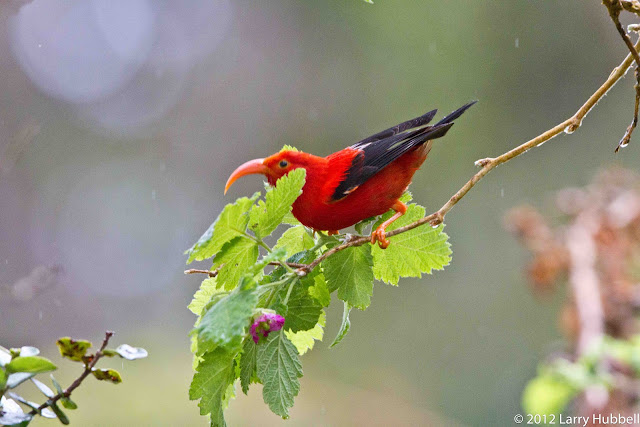The name for this week's post, "& Red All Over", comes from three Hawaiian Forest birds. Hundreds of years ago the Hawaiian islands were virtually covered in forests. There were two primary trees in these forests. The trees were the Koa and the Ohi'a (pronounced "O-He-ah"). Generally, the Ohi'a tree has a beautiful red flower.
This post is about three crimson birds whose color matches this flower.
Today the remaining native Hawaiian forests are generally found above four or five thousand feet. The introduction of cattle and pigs to Hawaii has been a major factor in destroying much of the Hawaiian forests, not to mention the rich, dark beauty of the Koa wood which even today is made into beautiful furniture. At the same time there has been a corresponding decline in the number of forest birds in terms of absolute numbers and species. The accidental introduction of the mosquito and avian flu has not helped the forest birds either. At this time the cold nights in the the highland forests seem to be keeping the mosquitos away from the last of these unique forest birds. The native Hawaiian forest birds are found no where else on earth.
The most common of our three red birds is the Apapane, then the I'iwi (pronounced "E-E-vee") and the least common is the Akepa. The Apapane can be seen on Kauai, Maui and in multiple places on the Big Island, less often the I'Iwe can be found in similar areas. The Akepas are not nearly so wide spread, read more here. One of the few places they can still be seen is in the Hakalua Forest National Wildlife Refuge. Hakalua means "many perches", it is the first National Wildlife Refuge created for these forest birds. It is not open to the general public and is not easily accessible, however Ecotours are available from Hawaii Forest & Trail (HF&T).
Our visit to Hakalua started out a half hour north of Kona. Garry Dean, our guide,
picked us up at 7:15 am in a 12-14 person, specially-adapted four-wheel drive van. After a couple of hours of car birding and learning we reached our breakfast stop at around 6000 feet in the "saddle" between the Mauna Kea and Mauna Loa. The next hour or so was spent covering 10 miles on a rugged rocky 4-wheel-drive-only road. Our single stop was to see a Hawaiian Hawk.
This hawk is not one of the forest birds but it is only found on the Big Island of Hawaii.
Just after 11am we reached Hakalua. We stepped happily out of the vehicle to see endangered Hawaiian Nene casually feeding nearby.
As we packed the lunches provided by HF&T, an Apapane sang from the top of a nearby tree.
Garry explained the history of Hakalua. Before the NWR was created, cattle grazing in this area destroyed most of the native undergrowth, but many of the large old growth trees remained. Since the refuge was created in 1985, a tremendous effort has been taking place to replace the missing native undergrowth and add additional trees. A lot of non-native grass remains, however the native plants are clearly making a come back. A big part of the effort is maintaining the 400 miles of fencing needed to keep out non-native creatures. In addition to cows, pigs and goats also tear up and eat the native plants.
We enjoyed beautiful sunshine until just after lunch, surrounded by the sounds of wingbeats, bird calls and passing views of the Apapane,
the I'Ivi
and the Amakihi.
The Amikihi has a different strategy than our three red birds, it tends to blend in with the leaves instead of the flowers. There was however no sign of the Akepa.
After lunch the clouds blew in and the rain began to fall, which is not so surprising in a rainforest. What was surprising was how Garry simply ignored the rain and pushed on in search of the Akepa. Finally, in a small clearing deep below the canopy he spotted the Akepa. Gary worked hard to help us find and focus on the small red bird flitting about in the top of the the old growth trees. I got a few shots while trying to protect my camera from the rain. In the poor light and with the distances involved I honestly could not identify the bird through my view finder. I was actually wondering if it really was an Akepa. Since all I could see was a red bird, it could as easily have been an Apapane or an I'ivi. It wasn't until later when I was reviewing the photos that I could actually prove to myself that the bird was truly the Akepa.
Although not a great photo it is clear the bird does not have the white rump of an Apapane or the orange beak of an I'Ivi. Garry's ability to lead us on such a long journey, to preserver in the face of bad roads and rain and actually find and see this small endangered and beautiful bird is truly impressive.
On the way out we encountered one more bird I had never seen before, the Hawaiian Thrush.
While this trip requires a commitment of time, dollars and effort (when many folks might be happier on the beach) it was truly worth it to see these extremely rare and endangered birds. Even though the Akepa was clearly the highlight of this trip, my personal favorite is the I'Ivi.
By the way, the Hawaiian raspberry has no natural enemies so it also has no thorns.
I hope you enjoyed this vicarious vacation. :-)
Larry













Great article! Thanks for sharing and more power to you!
ReplyDeleteAmazing photos of salmon on your site for Togiak Lodge. Maybe someday we could have salmon like that spawning in streams flowing into Union Bay.
Delete